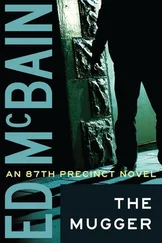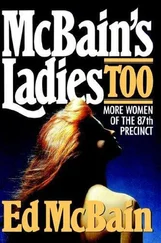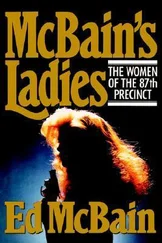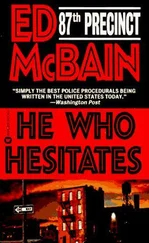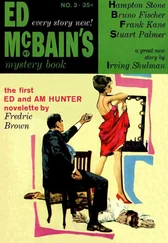Ed McBain - Eight Black Horses
Здесь есть возможность читать онлайн «Ed McBain - Eight Black Horses» весь текст электронной книги совершенно бесплатно (целиком полную версию без сокращений). В некоторых случаях можно слушать аудио, скачать через торрент в формате fb2 и присутствует краткое содержание. Жанр: Полицейский детектив, на английском языке. Описание произведения, (предисловие) а так же отзывы посетителей доступны на портале библиотеки ЛибКат.
- Название:Eight Black Horses
- Автор:
- Жанр:
- Год:неизвестен
- ISBN:нет данных
- Рейтинг книги:5 / 5. Голосов: 1
-
Избранное:Добавить в избранное
- Отзывы:
-
Ваша оценка:
- 100
- 1
- 2
- 3
- 4
- 5
Eight Black Horses: краткое содержание, описание и аннотация
Предлагаем к чтению аннотацию, описание, краткое содержание или предисловие (зависит от того, что написал сам автор книги «Eight Black Horses»). Если вы не нашли необходимую информацию о книге — напишите в комментариях, мы постараемся отыскать её.
Eight Black Horses — читать онлайн бесплатно полную книгу (весь текст) целиком
Ниже представлен текст книги, разбитый по страницам. Система сохранения места последней прочитанной страницы, позволяет с удобством читать онлайн бесплатно книгу «Eight Black Horses», без необходимости каждый раз заново искать на чём Вы остановились. Поставьте закладку, и сможете в любой момент перейти на страницу, на которой закончили чтение.
Интервал:
Закладка:
According to the preliminary report of the medical examiner’s office, the lady in the park had not been raped—either before her death or after it, a not uncommon occurrence in this civilized city.
She had been shot in the back of the head, gangland style.
A single bullet had done the job, but there were no spent cartridge cases or bullets at the scene. An automatic weapon ejects cartridge cases when it is fired. A revolver retains the spent cartridge cases in its cylinder. But whenever type of pistol had been used, if the lady had been shot and killed m Grover Park, there would have been a spent bullet somewhere in the vicinity. The exit wound in her throat told them that. They could find no bullet. Which indicated to them that the lady had been shot elsewhere and only later transported to the park.
It is a myth that the Identification Section of any cosmopolitan police department can immediately identify anyone merely by checking his or her fingerprints against what is known as the base file. The base file in this city was divided into two sections, the largest of which—occupying an entire floor of the Headquarters Building downtown on High Street—was itself subdivided into two sections, one devoted exclusively to maintaining an up-to-date fingerprint record of anyone charged with or convicted of a felony or a misdemeanor, the other composed of latent fingerprints taken at the scene of a crime. The overall section was called the Criminal Section of the Identification Section, or the CSIS, bastardized in police jargon to just plain ‘Sissies.’ The Sissies file devoted to known criminals was called the A-file, and the file holding latents was called the B-file.
A check of the A-file revealed no criminal record for the lady found dead in the park.
A check of the B-file came up negative against any latent prints on record.
This meant only that she had never committed a crime for which she’d been caught, and had never left her fingerprints at the scene of a crime.
The second file in the I.S. maintained fingerprint records of anyone involved in the city’s vast law enforcement organization, anyone working as a security officer in a municipal jail or prison and anyone who had been granted a carry or premises permit for a pistol.
That was it.
On the municipal level.
But the United States is a big, big country, and it is also a free country, which means that anyone —even if he is intent on doing criminal mischief—can travel from city to city and state to state without an identity card or a by-your-leave from the local commissar. This is one of the nice things about living in a democracy. It is also a headache for law enforcement officers. The city for which Carella worked was the largest city in the state, but the fingerprint files in its police department’s Identification Section were minuscule compared to those in the state depository, some hundred and fifty miles to the north. When Isola’s I.S. section came up blank on Jane Doe, a search-and-return request was automatically sent upstate. The prints taken from the corpse were checked against the state’s base file, and the results were identical: no record.
The buck could have stopped there, but it didn’t.
A check with the FBI’s national files came back with a negative response: no criminal record for Jane Doe. Neither had she ever been fingerprinted for service in the armed forces or for any job considered security-sensitive by the Nuclear Regulatory Commission.
Carella knew that the I.S. routinely ran courtesy checks for any institution whose employees handled large sums of money. Had any bank in the city sent Jane Doe’s fingerprints to the I.S. for a verification check against Sissies? The I.S. replied that such courtesy checks were made on a search-and-return basis, as opposed to a search-and- retain basis. In other words, after either a full or limited search-and-return was made, the I.S. automatically sent the fingerprints back to the financial institution or other commercial entity making the request. They did not retain the fingerprints in their files. Even if someone in Jane Doe’s immediate or distant past had requested a search against the Sissies file, there would be no record of it.
Period.
End of story.
All of this took the better part of a week.
By that time, though, the police department had circulated to the Missing Persons Section and to every precinct in the city a photograph and description of Jane Doe, together with a copy of the Detective Division report Carella himself had typed up on the morning the body was discovered.
On Wednesday morning, November 2, Carella got a call from a Detective Lipman at Missing Persons.
Lipman told him he had a positive ID on the dead woman.
* * * *
CHAPTER TWO
The woman who had identified Jane Doe was staying at a once-elegant midtown hotel that now emanated an air of shabby dignity, like an exiled dowager empress praying for return to the throne. Huge marble columns dominated the lobby, where sagging sofas rested on frayed Persian rugs. The ornately carved and gilded mahogany registration desk was cigarette-scarred. Even the clerk who told them what room Miss Turner was in looked faded, his gray hair a shade lighter than his gray suit, his black tie as funereal as his dark somber eyes. The elaborate brass fretwork on the elevator doors reminded Carella of something he had seen in a spy movie.
Inge Turner was a slender blonde in her late thirties, they guessed, her complexion as fair as her sister’s had been, her eyes the same shade of blue. She was wearing a simple blue suit over a white blouse with a stock tie. Medium-heeled blue pumps on good legs. A gold pin in the shape of a bird pinned to the lapel of the suit jacket. Blue eyeliner. Lipstick that was more-pink than red.
‘Gentlemen,’ she said. ‘Please come in.’
The room was small, dominated by a king-size bed. Inge sat on the edge of the bed, crossing her legs. The detectives sat in upholstered chairs near musty drapes hanging over a window that was open to the sounds of traffic on the avenue six stories below. Already the second of November, and Indian summer was still with them. It would come with a vengeance, winter. It would come suddenly and unexpectedly, hurling false expectations back into their teeth.
‘Miss Turner,’ Carella said, ‘Detective Lipman at Missing Persons tells us...’
‘Yes,’ she said.
‘... that you’ve identified a photograph in his files as ...’
‘Yes,’ she said again.
‘... your sister, Elizabeth Turner.’
‘That’s correct.’
‘Miss Turner, I wonder if you could look at that picture again ... I have a print here...’
‘Must I?’ she said.
‘I know it’s difficult,’ Carella said, ‘but we want to make sure...’
‘Yes, let me see it,’ she said.
Carella took the photograph from the manila file envelope. As photographs of corpses went, it was not too grisly—except for the exit wound in the hollow of the throat. Inge looked at it briefly, said, ‘Yes, that’s my sister,’ and then reached for her handbag, took a cigarette from it, said, ‘Do you mind if I smoke?’ and lighted it without waiting for an answer.
‘And her full name is Elizabeth Turner?’ Carella said.
‘Yes. Well, Elizabeth Anne Turner.’
‘Can you tell us how old she was?’ Brown asked.
‘Twenty-seven,’ Inge said.
Both detectives thought, at precisely the same moment, that for once in his lifetime Monoghan had been right.
‘And her address?’
‘Here or in California?’ Inge said.
‘I’m sorry, what... ?’
‘She used to live with me in California.’
Читать дальшеИнтервал:
Закладка:
Похожие книги на «Eight Black Horses»
Представляем Вашему вниманию похожие книги на «Eight Black Horses» списком для выбора. Мы отобрали схожую по названию и смыслу литературу в надежде предоставить читателям больше вариантов отыскать новые, интересные, ещё непрочитанные произведения.
Обсуждение, отзывы о книге «Eight Black Horses» и просто собственные мнения читателей. Оставьте ваши комментарии, напишите, что Вы думаете о произведении, его смысле или главных героях. Укажите что конкретно понравилось, а что нет, и почему Вы так считаете.


